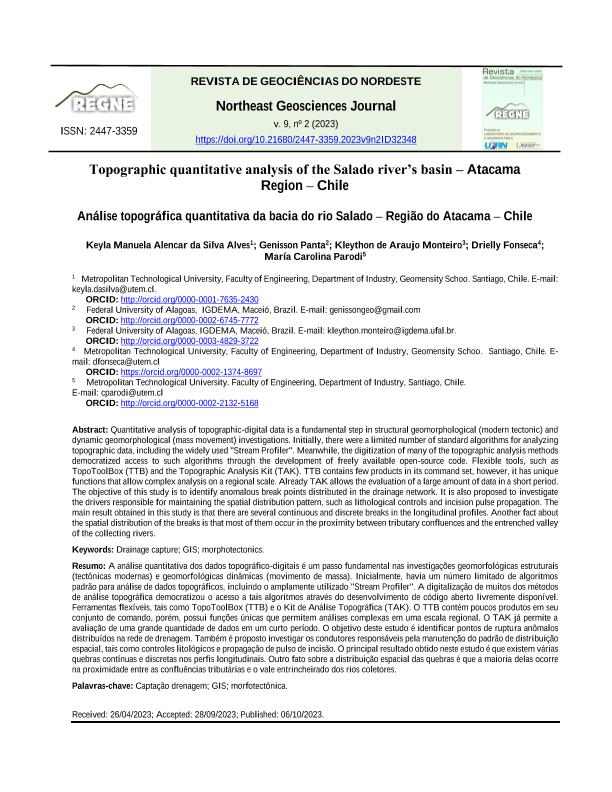Artículo
Quantitative analysis of topographic-digital data is a fundamental step in structural geomorphological (modern tectonic) and dynamic geomorphological (mass movement) investigations. Initially, there were a limited number of standard algorithms for analyzing topographic data, including the widely used "Stream Profiler". Meanwhile, the digitization of many of the topographic analysis methods democratized access to such algorithms through the development of freely available open-source code. Flexible tools, such as TopoToolBox (TTB) and the Topographic Analysis Kit (TAK). TTB contains few products in its command set, however, it has unique functions that allow complex analysis on a regional scale. Already TAK allows the evaluation of a large amount of data in a short period. The objective of this study is to identify anomalous break points distributed in the drainage network. It is also proposed to investigate the drivers responsible for maintaining the spatial distribution pattern, such as lithological controls and incision pulse propagation. The main result obtained in this study is that there are several continuous and discrete breaks in the longitudinal profiles. Another fact about the spatial distribution of the breaks is that most of them occur in the proximity between tributary confluences and the entrenched valley of the collecting rivers. A análise quantitativa dos dados topográfico-digitais é um passo fundamental nas investigações geomorfológicas estruturais (tectônicas modernas) e geomorfológicas dinâmicas (movimento de massa). Inicialmente, havia um número limitado de algoritmos padrão para análise de dados topográficos, incluindo o amplamente utilizado "Stream Profiler". A digitalização de muitos dos métodos de análise topográfica democratizou o acesso a tais algoritmos através do desenvolvimento de código aberto livremente disponível. Ferramentas flexíveis, tais como TopoToolBox (TTB) e o Kit de Análise Topográfica (TAK). O TTB contém poucos produtos em seu conjunto de comando, porém, possui funções únicas que permitem análises complexas em uma escala regional. O TAK já permite a avaliação de uma grande quantidade de dados em um curto período. O objetivo deste estudo é identificar pontos de ruptura anômalos distribuídos na rede de drenagem. Também é proposto investigar os condutores responsáveis pela manutenção do padrão de distribuição espacial, tais como controles litológicos e propagação de pulso de incisão. O principal resultado obtido neste estudo é que existem várias quebras contínuas e discretas nos perfis longitudinais. Outro fato sobre a distribuição espacial das quebras é que a maioria delas ocorre na proximidade entre as confluências tributárias e o vale entrincheirado dos rios coletores.
Topographic quantitative analysis of the Salado river’s basin – Atacama Region – Chile
Título:
Análise topográfica quantitativa da bacia do rio Salado – Região do Atacama – Chile
Alencar Da Silva Alves, Keyla Manuela ; Panta, Genisson; de Araujo Monteiro, Kleython; Fonseca, Drielly; Parodi, María Carolina
; Panta, Genisson; de Araujo Monteiro, Kleython; Fonseca, Drielly; Parodi, María Carolina
 ; Panta, Genisson; de Araujo Monteiro, Kleython; Fonseca, Drielly; Parodi, María Carolina
; Panta, Genisson; de Araujo Monteiro, Kleython; Fonseca, Drielly; Parodi, María Carolina
Fecha de publicación:
07/2023
Editorial:
Universidade Federal do Rio Grande do Norte
Revista:
Revista de Geociencias do Nordeste
ISSN:
2447-3359
Idioma:
Inglés
Tipo de recurso:
Artículo publicado
Clasificación temática:
Resumen
Palabras clave:
DRAINAGE CAPTURE
,
GIS
,
MORPHOTECTONICS
Archivos asociados
Licencia
Identificadores
Colecciones
Articulos(CCT - ROSARIO)
Articulos de CTRO.CIENTIFICO TECNOL.CONICET - ROSARIO
Articulos de CTRO.CIENTIFICO TECNOL.CONICET - ROSARIO
Citación
Alencar Da Silva Alves, Keyla Manuela; Panta, Genisson; de Araujo Monteiro, Kleython; Fonseca, Drielly; Parodi, María Carolina; Topographic quantitative analysis of the Salado river’s basin – Atacama Region – Chile; Universidade Federal do Rio Grande do Norte; Revista de Geociencias do Nordeste; 9; 2; 7-2023; 110-119
Compartir
Altmétricas



